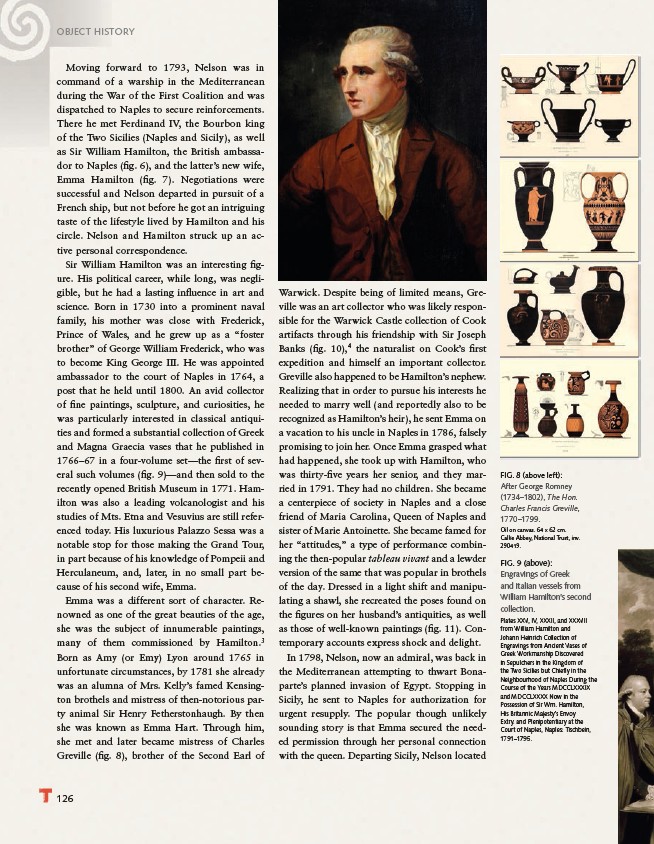
OBJECT HISTORY
Moving forward to 1793, Nelson was in
command of a warship in the Mediterranean
during the War of the First Coalition and was
dispatched to Naples to secure reinforcements.
There he met Ferdinand IV, the Bourbon king
of the Two Sicilies (Naples and Sicily), as well
as Sir William Hamilton, the British ambassador
126
to Naples (fi g. 6), and the latter’s new wife,
Emma Hamilton (fi g. 7). Negotiations were
successful and Nelson departed in pursuit of a
French ship, but not before he got an intriguing
taste of the lifestyle lived by Hamilton and his
circle. Nelson and Hamilton struck up an active
personal correspondence.
Sir William Hamilton was an interesting fi gure.
His political career, while long, was negligible,
but he had a lasting infl uence in art and
science. Born in 1730 into a prominent naval
family, his mother was close with Frederick,
Prince of Wales, and he grew up as a “foster
brother” of George William Frederick, who was
to become King George III. He was appointed
ambassador to the court of Naples in 1764, a
post that he held until 1800. An avid collector
of fi ne paintings, sculpture, and curiosities, he
was particularly interested in classical antiquities
and formed a substantial collection of Greek
and Magna Graecia vases that he published in
1766–67 in a four-volume set—the fi rst of several
such volumes (fi g. 9)—and then sold to the
recently opened British Museum in 1771. Hamilton
was also a leading volcanologist and his
studies of Mts. Etna and Vesuvius are still referenced
today. His luxurious Palazzo Sessa was a
notable stop for those making the Grand Tour,
in part because of his knowledge of Pompeii and
Herculaneum, and, later, in no small part because
of his second wife, Emma.
Emma was a different sort of character. Renowned
as one of the great beauties of the age,
she was the subject of innumerable paintings,
many of them commissioned by Hamilton.3
Born as Amy (or Emy) Lyon around 1765 in
unfortunate circumstances, by 1781 she already
was an alumna of Mrs. Kelly’s famed Kensington
brothels and mistress of then-notorious party
animal Sir Henry Fetherstonhaugh. By then
she was known as Emma Hart. Through him,
she met and later became mistress of Charles
Greville (fi g. 8), brother of the Second Earl of
Warwick. Despite being of limited means, Greville
was an art collector who was likely responsible
for the Warwick Castle collection of Cook
artifacts through his friendship with Sir Joseph
Banks (fi g. 10),4 the naturalist on Cook’s fi rst
expedition and himself an important collector.
Greville also happened to be Hamilton’s nephew.
Realizing that in order to pursue his interests he
needed to marry well (and reportedly also to be
recognized as Hamilton’s heir), he sent Emma on
a vacation to his uncle in Naples in 1786, falsely
promising to join her. Once Emma grasped what
had happened, she took up with Hamilton, who
was thirty-fi ve years her senior, and they married
in 1791. They had no children. She became
a centerpiece of society in Naples and a close
friend of Maria Carolina, Queen of Naples and
sister of Marie Antoinette. She became famed for
her “attitudes,” a type of performance combining
the then-popular tableau vivant and a lewder
version of the same that was popular in brothels
of the day. Dressed in a light shift and manipulating
a shawl, she recreated the poses found on
the fi gures on her husband’s antiquities, as well
as those of well-known paintings (fi g. 11). Contemporary
accounts express shock and delight.
In 1798, Nelson, now an admiral, was back in
the Mediterranean attempting to thwart Bonaparte’s
planned invasion of Egypt. Stopping in
Sicily, he sent to Naples for authorization for
urgent resupply. The popular though unlikely
sounding story is that Emma secured the needed
permission through her personal connection
with the queen. Departing Sicily, Nelson located
FIG. 8 (above left):
After George Romney
(1734–1802), The Hon.
Charles Francis Greville,
1770–1799.
Oil on canvas. 64 x 62 cm.
Calke Abbey, National Trust, inv.
290419.
FIG. 9 (above):
Engravings of Greek
and Italian vessels from
William Hamilton’s second
collection.
Plates XXV, IV, XXXII, and XXXVII
from William Hamilton and
Johann Heinrich Collection of
Engravings from Ancient Vases of
Greek Workmanship Discovered
in Sepulchers in the Kingdom of
the Two Sicilies but Chiefl y in the
Neighbourhood of Naples During the
Course of the Years MDCCLXXXIX
and MDCCLXXXX Now in the
Possession of Sir Wm. Hamilton,
His Britannic Majesty’s Envoy
Extry. and Plenipotentiary at the
Court of Naples, Naples: Tischbein,
1791–1795.